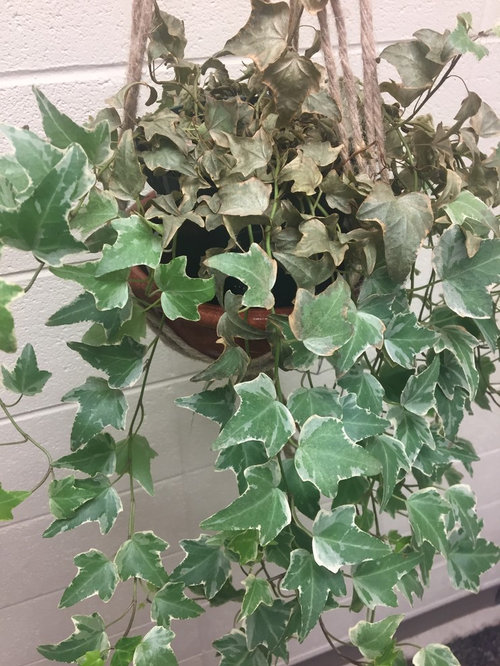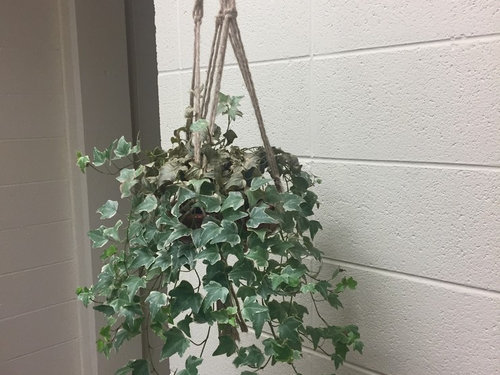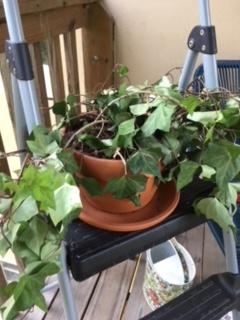
The most common causes of dying ivy plants include underwatering, overwatering, and being placed in pots that are too small and have restricted access to moisture and nutrients. Your ivy is probably becoming brown and withering back because of dry soil, too much sun, and inadequate irrigation.
Ivy needs to be watered properly, planted in the proper-sized pot, and, if necessary, fertilized in order to be revived. To encourage strong green growth, dying leaves should be reduced in size.
Continue reading to find out why and how to revive Ivy if it starts to turn brown, yellow, stop growing properly, or look dead.
Table of Contents
Dry soil- Ivy Leaves Turning Brown
Drought is the blame for a fading ivy plant with browning leaves.
Ivy has to be watered once a week with a good soak to keep healthy, but depending on your conditions, you could need to water more frequently.
The ivy becomes brown and dies back if the soil dries up too rapidly due to small pots with little soil, high temperatures, or excessive sunlight.
Even if you routinely water your ivy plant, it may still experience the effects of drought and die back due to:
- Less pots and containers have a smaller soil holding capacity and, as a result, hold less moisture, which causes them to dry out too rapidly for your ivy.
- Ivy needs a good soak every time you water it. If you water your ivy too lightly, it might just reach the top inch of the soil and not soak all the way down to the roots.
- Low humidity and high temperatures can both increase the amount of moisture that evaporates from the soil, causing your potted ivy to become brown.
- The afternoon sun might accelerate evaporation if your Ivy is outdoors and exposed to direct sunlight.
The browning and death of your ivy’s leaves can be caused by a variety of circumstances.
How to Revive an Ivy Dying Back with Brown Leaves
Watering your ivy properly for your climate or indoor settings is the key to keeping it alive.
In most regions, watering once per week is ideal since it allows the soil to partially dry out between applications, which is the ivy’s desired balance of soil moisture.
However, you must modify the watering schedule if you live in a dry area with low humidity so that the soil seems dry on the surface but does not entirely dry out at the roots.
When in doubt about when to water your ivy, stick your finger in the ground and feel for wetness. Ideally, the soil’s surface should feel dry but you should be able to feel some wetness, indicating that the soil hasn’t totally dried out.
potted water Ivy it until you see a trickle of water coming out of the drainage hole at the pot’s base. In order for the ivy to remain healthy, this makes sure that the water has reached the roots.
It’s crucial to put your ivy in a pot or container that is the right size.
A larger pot has more soil capacity and may hold moisture better, especially in hot climates. This lets the roots to receive more nutrients and keeps them from becoming pot-bound.
In order to prevent drought and brown leaves, move your ivy to a larger pot if the roots are visibly pot-bound. A pot that is about 10 inches across is ideal for warmer conditions.
With a pair of pruners, remove any brown leaves or dead plant parts to encourage new, green growth.
Cutting back should encourage fresh, healthy growth to help your ivy recover if the individual leaves are completely brown and unlikely to regenerate.
(For more on the best watering techniques, see my post on how to water ivy plants.)
Too Much Sun can Scorch Ivy Leaves

Ivy enjoys shade, partial sun, or dappled light and is a woodland climber.
Reposition the ivy in a location with strong indirect light or with morning sun and afternoon shade.
Most sun exposure issues are brought on by moving a potted ivy to a different area of the house or garden with a different level of light.
If Ivy is used to the shadow, moving it to a sunny place may cause the leaves to appear burnt and the plant to appear to be dying.
Ivy is a resilient plant that can adapt to more sunlight, but it is best to gradually expose the plant to more light by moving the pot or container to a sunnier area for a few hours so it can adjust to the different level of light rather than having to adjust to the contrast from a shady area to a sunny area.
Another factor to take into account is how much sun exposure might affect how much water evaporates from the soil and foliage.
Make sure your ivy is in a good-sized pot or container (bigger pots can hold more moisture) and maintain the plant well-watered to minimize any potential negative effects (with a good soak once per week).
The ivy should recover if you keep an eye out for any indications of extremely dry soil and increase the frequency of your watering accordingly.
As severely damaged leaves are unlikely to recover, you can cut back any highly burned or brown foliage to encourage new development.
Ivy Turning Yellow/Brown and Dying due to Over Watering
Your ivy’s leaves may turn brown or yellow from an excess of moisture in the base, and the plant will eventually wither.
This could be caused by overwatering, pots without drainage, or a soil mixture with slow drainage.
The ivy plant dies when too much water in the soil deprives the roots of oxygen, turning the leaves yellow.
Ivy needs potting soil that is lighter, more aerated, and most importantly, good draining, as these characteristics resemble the soil conditions found in its natural habitat.
Ivy would rather the soil get a little bit drier in between waterings than have it always be wet.
There are a several causes of excess moisture at the roots, including:
- water accumulating beneath pots or other containers with no drainage holes in the base.
- irrigating the ivy excessively.
- Heavy or compacted soil that inhibits proper drainage and lowers soil oxygen levels
- Gardening in naturally wet or low-lying locations, whether grown outside.
Revive Dying Ivy Turning Yellow Due to Over Watering
You are overwatering your Ivy if you give it water each day. Reduce watering to once a week or so so that the soil can dry out in between applications.
If ivy is grown in pots or containers without drainage holes, the soil will quickly become soggy.
Transfer your ivy to a pot with drainage holes in the base so that any extra water may drain as ornamental plant pots occasionally lack drainage.
Using a drip tray to collect the extra water that drips out of the base of the pot is a very typical error made when growing ivy.
The ivy becomes yellow and withers away as a result of the water pooling underneath the pot and the soil remaining moist, which simulates a pot without drainage holes.
If you’re worried about watering your ivy indoors, I suggest using a saucer or a cloth to transfer the pot to the sink after watering. Just make sure that no water collects underneath the pot and the soil doesn’t get too wet.
The ivy should begin to heal if there is no water stress, but if the soil has been consistently damp for a long time, the ivy may have root rot, which makes recovery challenging.
Reduce any yellow foliage to encourage the development of wholesome, green leaves.
(Read my article to learn why my ivy is yellowing.)
Ivy Turn Yellow Due to Lack of Fertilizer
Yellow leaves on your Ivy plant can also be caused by fungus and overwatering.
Ivy is mostly a foliage plant, and in order to stay healthy and green, it needs a sufficient source of nitrogen.
Ivy might cease growing and its leaves can turn yellow and die off if it is planted in soil that lacks nitrogen.
Ivy may lack nitrogen for a variety of reasons.
- The roots of the ivy may deplete the potting soil of nutrients if it has been growing in the same pot for a long period, which will cause the leaves to turn yellow.
- The roots of the ivy may be pot-bound and unable to obtain the nitrogen and other nutrients needed to grow and maintain the color of the leaves if it is put in a small pot or container.
Revive Ivy in Pots Turning Yellow
You should move the Ivy to a bigger pot or container with fresh potting soil if it has turned yellow in a pot owing to a lack of nitrogen in the potting soil.
More nutrients are present in the new potting soil, allowing your Ivy to start recovering. Additionally, a bigger pot has more potting soil in it, giving the roots more freedom to access the nitrogen in the soil without being constrained by the pot.
Remove any yellowing foliage as it is unlikely to recover, and prune any new growth to promote healthy, green leaf development.
However, it is best practice to apply an ivy fertilizer to assist maintain the leaves green and the plant healthy. These adjustments can help your ivy recover.
To guarantee that your ivy has all the nutrients it needs to grow and stay green, treat it using a typical house plant fertilizer every two months during the spring and summer.
Indoor Potted Ivy Dying

- interior temperature changes. Ivy prefers temperatures that are more stable, so keep it away from radiators, heat sources, air currents, forced air, and air conditioning to prevent drying out and dying foliage.
- Spider mites might be a problem if you live in an extremely dry climate. In homes that are warm, dry, and have low humidity levels, spider mites are more common.
Ivy leaves with spider mite infestation often have tiny yellow dots that gradually turn brown and wilt and have a dried-out appearance.
The leaves of the ivy should be washed in soapy water made from dishwashing detergent in order to get rid of a spider mite infestation.
The spider mites causing the damage can be removed by washing the leaves or using a spray bottle. This will stop them from returning for a while.
If the infestation is severe, it could take multiple washing to entirely get rid of the mites.
Trim back any foliage that has been negatively impacted, which should encourage new, healthy development and help the ivy recover.
